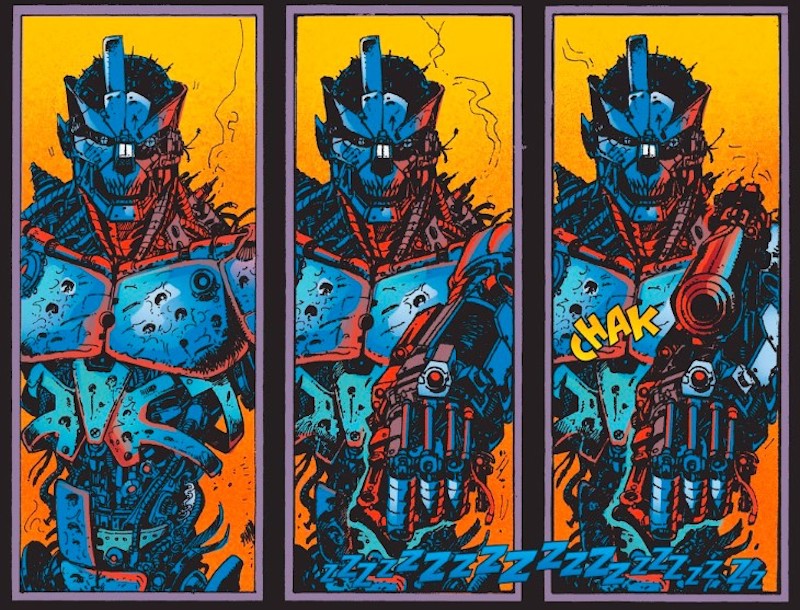There’s a moment in Frederik Pohl’s 1976 novel Man Plus, a tale of a man being transformed, in which the protagonist starts to gain a degree of understanding of what is being done to him. What he soon comes to realize is that he can’t really apprehend his new state at all; he still thinks in human terms while his being is now something quite different:
“He was not conscious of very much else that pertained to his own body. His body-knowledge senses had not yet come to deal with the reality of his new body. He did not know when his eyes, lungs, heart, ears, nose and skin were replaced or supplemented. He didn’t know how to recognize the clues that might have given him information.”
For all its faults Man Plus is quite good at exploring this feeling of radical otherness. The protagonist, Roger Torraway –get it? He’s being ‘torn away’ from humanity! – isn’t some guy with metal bits stuck on top of him. Those metal bits didn’t just change him physically, they changed him mentally as well.
The concept of the ‘cyborg’ has been with us – in that particular name at least – for over sixty years now. Manfred Clynes coined it in the September issue of Astronautics in 1960, but the notion of altered humanity goes further back than that: What is Frankenstein if not an exploration of humanity’s attempt to conquer death by science? A man made with bits and pieces and (in the movie version at least) with electricity surging through him.
Ever since then we’ve been inundated with versions of the remade man, in television (Six Million dollar Man), in cinema (Robocop), in anime (Ghost in the Shell), and in comics.And while comics had its fair share of cyborgs, in both mainstream and alternative branches, one of the most interesting examples of them all is Deathlok. Introduced all the way back in 1974 (full two years before Man Plus), in the Marvel Comics anthology title Astonishing Tales, the character became a fascinating tool for various writers and artists to explore the ever-evolving terms of ‘cyborg’ and ‘transhumanity.’ Unlike most of his Marvel brethren, most superhero brethren actually, the concept isn’t nailed to a single character.
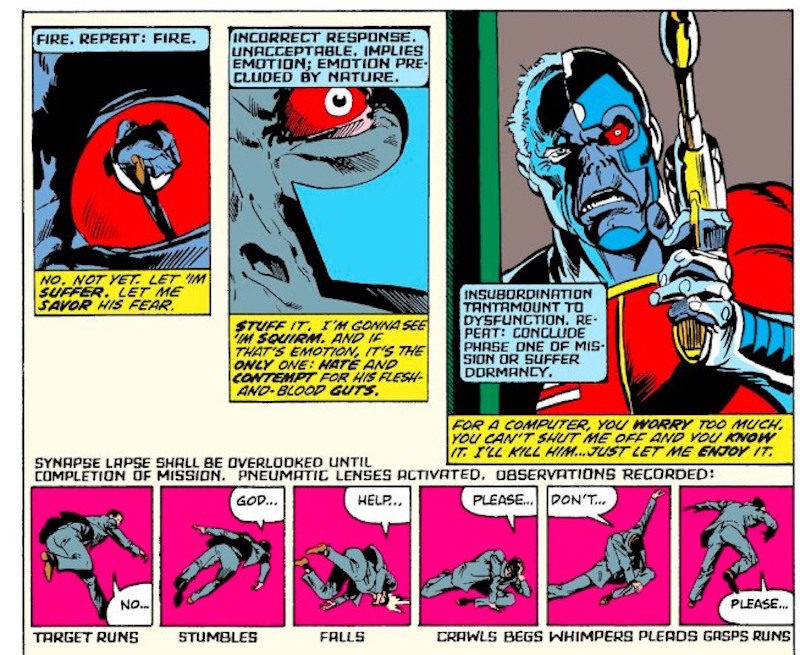
A perennial B or C-lister, the name and general design of Deathlok have been passed around quite a bit; from a future soldier too concerned scientist to cynical secret agent. This is only appropriate, as scholar Sue Short noted in her book Cyborg Cinema and Contemporary Subjectivity, as the cyborg is, paradoxically, a figure borne our rigid scientific principles that is nevertheless forever changing:
“Despite emanating from a scientific worldview that sought to make humans increasingly knowable, the cyborg appears to have produced a pronounced uncertainty with regard to identity[.]”
As time shifts, so does our conception of the cyborg, meaning that every iteration of Deathlok, especially the first three (that predate the 21st century) are not just different characters but different conceptions of what it means to be more than human.
The first version of Deathlok was very much Rich Buckler’s baby. Despite the eventual collection being a mishmash of Marvel Method credits – including Doug Moench, Bill Mentalo, Keith Pollard, Bob McLeod, Klaus Janson and more – Buckler’s name is the most recurring feature, as a plotter, artist, and occasional scripter, in the first Deathlok series.
Buckler wasn’t looking to make another superhero title. In his first story Deathlok takes place in an alternate future, with nary a hint of the wider Marvel universe. (Buckler claimed he wanted the Deathlok to be his own and resented anything that could allow other writers to use him.)
Instead, the work was meant as implicitly political, arising from buckler observing the world around him: “It seemed to be a time for the creation of a new archetype – one that would reflect the technological age we all were headed into (or, rather, the future that our world leaders seem to be making sure we are heading into) […] a character who would encounter much of the insanity of the modern world that I perceived even in my early twenties.”Deathlok the Demolisher is the tale of Luther Manning, a USA soldier gravely wounded during a training exercise only to be revived as a killer cyborg – guided by his superior Major Ryker to kill all who stand his way. Manning, however, rebels both against his superior and his programing, setting on a bodies-strewn path to vengeance.
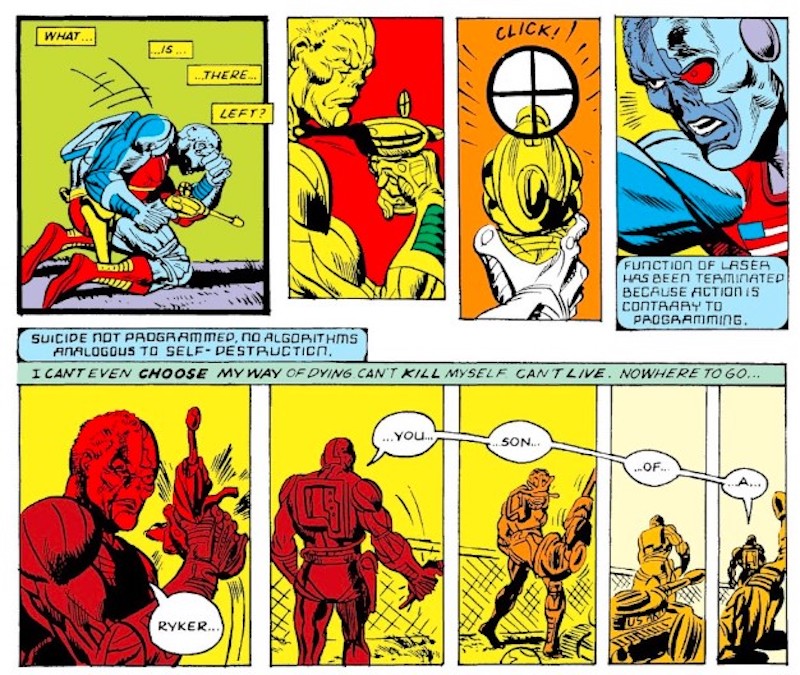
The first thing one notices about 1970’s Deathlok is the words. There are…a lot of them. This was not particularly uncommon for that era of Marvel, of course, as Claremont and McGregor were king; but here they crowd in a very particular style – lots and lots of caption boxes and less thought balloons. There are caption boxes for the omniscient narrator, there are caption boxes for Luther Manning, and there are even, somehow, caption boxes for the ‘Puter – Manning’s CPU which constantly guides his path for the most ‘logical’ solution.
These various caption boxes often seem antagonistic towards one another, as human and machine brain tangle over the best solution to each challenge – mirroring the crowding of the words with the crowding of images. Forget the six to nine panel grid, Buckler further subdivides the page in a manner evoking the great Bernie Krigstein, cutting down simple actions (jumping, running) into five and six panel rows. It makes the comics into a heavy read, even the shorter chapters take longer to read than your average modern issue, but is reflective of the mood Buckler was trying to evoke. These were the 1970’s after all, the era of future shock (the Alvin Toffler book, not the 2000AD term), in which the world grew both more connected and more threatening.
The cyborg, in this context, is the being that can try to make sense of it all. Manning’s computer brain processes information in a manner that allows him to survive this seemingly post-apocalyptic reality.
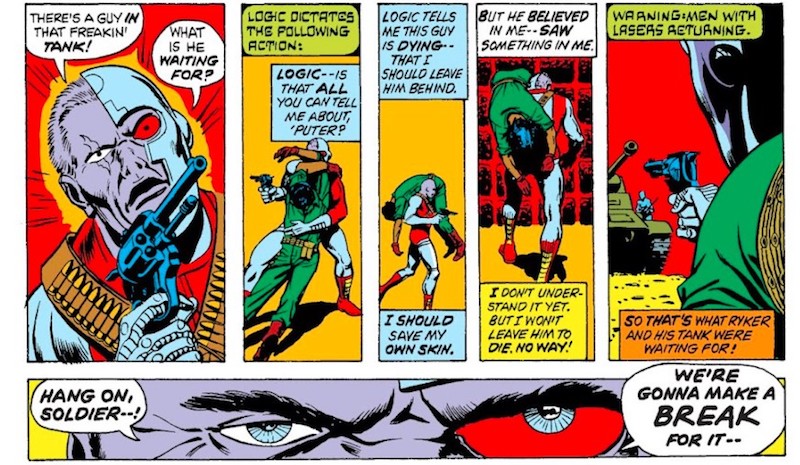
In many ways this version of Deathlok feels the closest to issues of present technology. Not so much the super computer threatening to take over the world, but the ever-present feeling of dealing with a buzzing voice in the back of your head. All the caption boxes that frustrate Manning might as well be tweets, or whatsapp messages. There’s breathlessness to the pacing, the series keeps throwing wild concepts at you, that evokes the algorithmic logic that governs video sites.
The same breathlessness and denseness that make the series unique also make it tiring. By the time Major Ryker tries to become the planet conquering Savior Machine you think you are getting close to the climax; not realizing Buckler has several more twists up his sleeve. When the story ends – with Deathlok shunted into the ‘present’ of the Marvel Universe for a series of crossovers – it’s less to do with reaching a conclusion (can you reach the ‘end’ of youtube?) and more with the limitations of the market. Not the military-industrial complex that made Deathlok (the cyborg), but the comics-industrial complex that made Deathlok (the series).
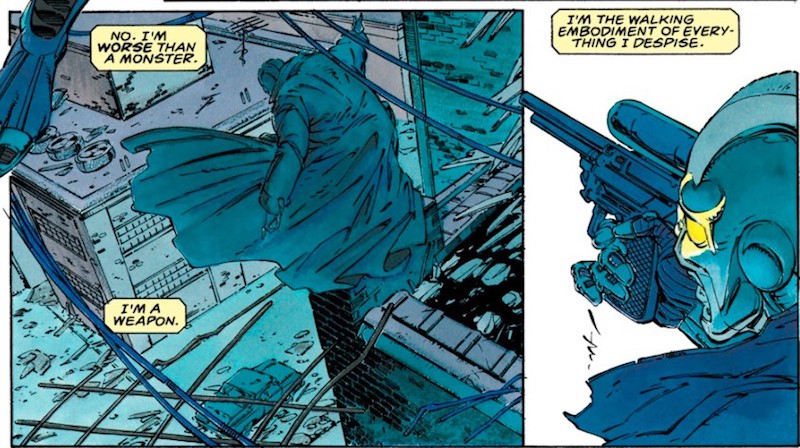
The next iteration of Deathlok set the course for the concept by being almost entirely different from its predecessor. The cyborg’s name is the same, and so is the general design, there’s a bad guy called Ryker and…that’s pretty much it. Written by Dwayne McDuffie and Gregory Wright, the 1990 Deathlok prestige miniseries (and the following 1991 ongoing miniseries) features a different kind of bot for a different kind of world.
Taking place in the present – and firmly within the Marvel universe – it features Professor Michael Collins, a pacifist working for Marvel all-purpose evil corporation Roxxon. Thinking he was making limbs for amputees, Collins is horrified to discover the company is using his research to make cyborgs for the military. When he tries to inform on them ,his boss has him silenced and uses his brain to power the new iteration of Deathlok; sending to him to a ‘field tests’ involving the murder of South American rebels opposing USA corporate takeover. Being forced to go against his deepest core beliefs by taking lives shocks Collins enough to allow him to take control of his new body, and then on to take on his bosses at Roxxon.
McDuffie and Wright set themselves a bigger challenge, and more interesting path with Collins: a man who now inhabits a living weapon that explicitly refuses to kill.
Taking the concept of military-industrial concept directly, the series explores the relation between business and the military, and the way both have the power to twist people into their own ends. Unlike the 1970’s series, in which the military was the sole responsible factor, this series took place directly in the post-Reagan era in which the forces of market capitalism sought to atomize individuals. Collins is shielded, at first, from the consequences of his work. He is an upwardly mobile Black man with a nice house and a nice family. He could’ve kept it all if only he kept his head down and played ball.

The utopian conception of the transhumanists is that science can make us malleable so that there’s nothing that couldn’t be achieved. However, as Hava Tirosh-Samuelson notes in her “Engaging Transhumanism”, this notion opens people for being manipulated by the powers-that-be. Being malleable is good only as long as you are able to shape yourself.
Collins has been remade against his will, by the system that sees every person (but especially Black people) as disposable tools. Collins’ rebellion becomes more meaningful than Manning’s because he does not simply turn his gun on his former corporate overlords. He does not seek vengeance through brute strength, but atonement by undoing his contribution to Roxxon.
It’s an intensely moral story, cutting to the question of personal responsibility. How much can we blame the individual for taking part in a wicked system? The answer it gives is remarkably clear – Collins is responsible for the ill use made of his technology. He cannot shriek away from the truth with excuses. When given a chance to achieve humanity once again, at the end of the mini-series, at the price of letting Ryker go free, he refuses. He refuses the company-mandated happy ending because that would mean he is still under their thumb, that they can dictate what he is. Collins refuses to be twisted and, despite being stuck in a cyborg body, still feels much more like a free man.
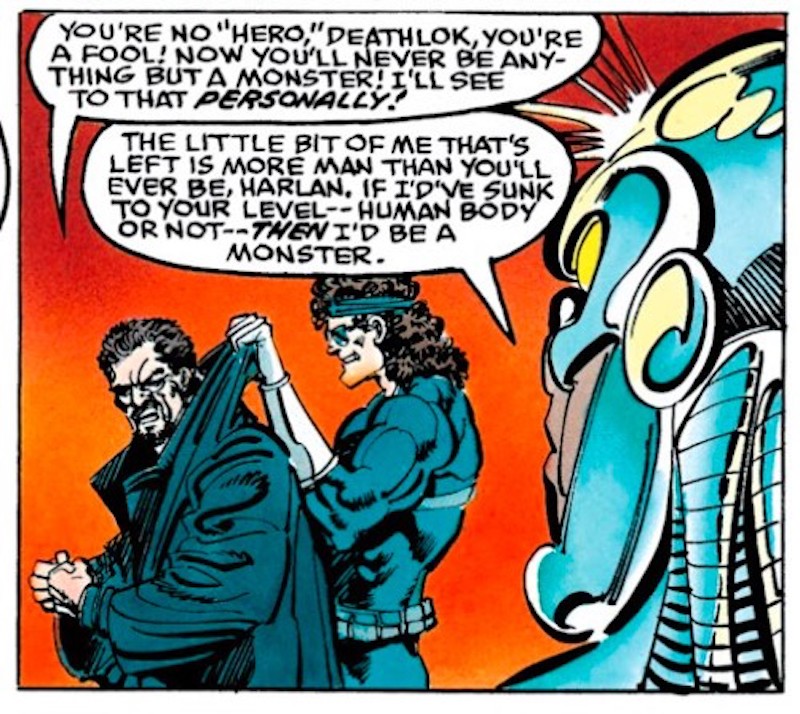
The third version of Deathlok, the final one to take place in the 20st century, was created by Joe Casey and Jose Ladronn and Leonardo Manco. This Deathlok had his own brief series as part of Marvel’s ill-fated M-Tech line of books (under the basic remit of ‘do something related to technology’). The failure of the M-Tech line is important, because it signifies that these big comics companies understood that society was about to change in some massive manner that is related to developing technologies, but they couldn’t quite conceptualize how it would change. As result the line was neither (cyber) fish nor (techno) fowl. An uncertain creation for an uncertain time.
It was, after all, the end of history. Previous versions of Deathlok came to be during a time of global conflict, as would future versions, but this one came out when American hegemony appeared at its zenith. As a result, the title felt far less angry and rebellious than its predecessors.
If Manning and Collins fought against the system, hated the system, the new Deathlok (former SHIELD agent Jack Truman) wasn’t that distraught by his transformation, and was pretty happy to stay under SHIELD’s pay. It’s either deeply cynical or deeply reactionary (or, as befitting the era of South Park, both). Also befitting the era, is the slightly more accepting view of technology. In the two previous versions, and especially the first one, there was inherent suspicion in the text towards technological advancement. If not something the authors themselves felt, then certainly something they expected the audience to feel. People were less familiar with the personal computer, original Deathlok still features some of the early designs of building-sized thinking machines.
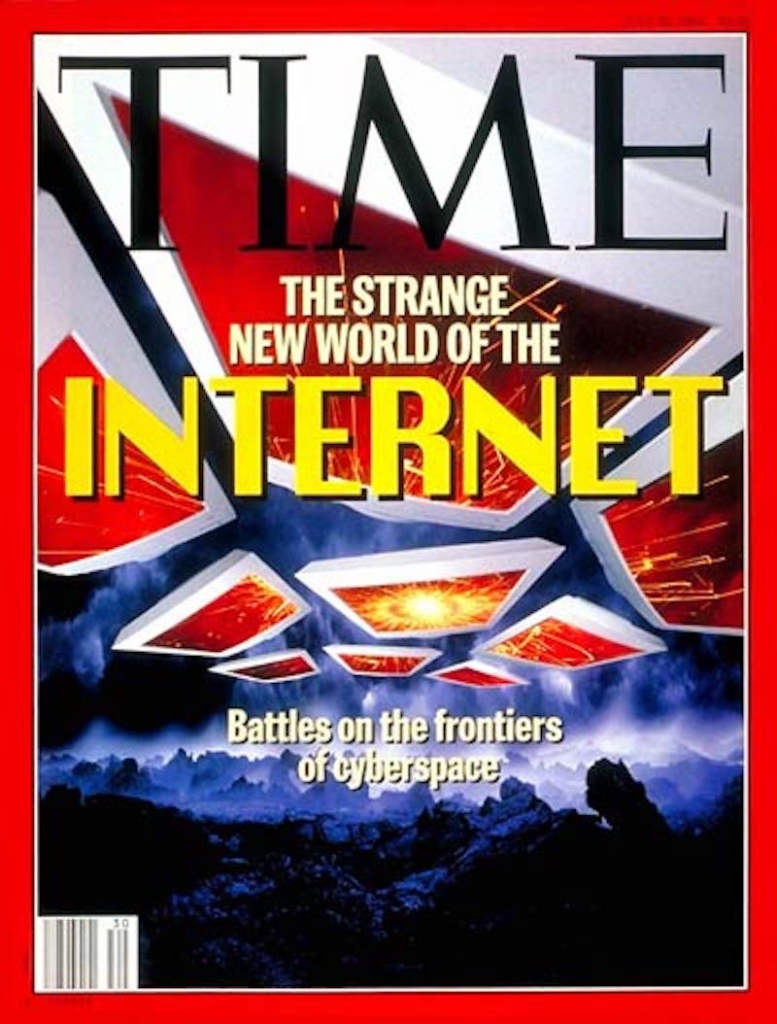
The third Deathlok series came as both computers and the internet were becoming common to the point of ubiquity. Time Magazine, as certainly a sign of public centrism in the 10th century, was reporting on “Battles on the Frontiers of Cyberspace” in 1994. We were all going to be Johnny Mnemonic, interfacing with virtual reality via specialized implants (cyberspace turned out to be much less exciting and yet much stranger). We were on the path to accept the cyborg, and Jack Truman was it: a man so unattached to the notions of body we see him casually hijacking the mind of a ten year old in issue #1, before he even gets the cyborg treatment.
If anything, the whole notion of Deathlok feels old fashioned, a vision of cutting-edge technophobia now twenty years out of date. This isn’t usually that much of a problem with most science fiction texts, which are reflections of their era only, but is an issue with long lasting comic book characters. The series ended rather abruptly, tying up all loose ends with machine-like efficacy, without ever quite nailing down the character of Truman. In a world in which everyone has a computer, the cyborg with one in his brain isn’t such a unique specimen.

This wasn’t the last of Deathlok. After all, this is comics; American cape comics to be precise, where nothing stays dead for long. There have been several revivals since – including one borne out of Deathlok’s appearance in the TV show Agents of SHIELD – with each feeling a bit less interesting than the last. There are seemingly half a dozen characters called ‘Deathlok’ running around in the Marvel universe, which certainly feels like too many. Cyborgs, like everything else, are subject to inflation.
It’s not that there is nothing more to say with the concept of ‘cyborg’. As Donna Haraway notes in A Cyborg Manifesto, there’s something inherently fluid about the notion. But there is very little to say about ‘Deathlok.’ All of which doesn’t make any of the older versions less interesting to engage with, but reminds us not that everything could, or should, last forever. The story of Deathlok is the story of our relationship with technology, with the promises of futurism and transhumanism in the 20th century, and perhaps it is just time to wave it goodbye.
